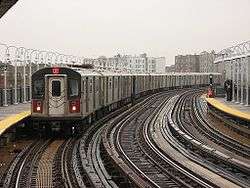Lo-V (New York City Subway car)
| Lo-V | |
|---|---|
 The four surviving "Low-Voltage" motor cars on layover on the IRT Jerome Avenue Line. | |
 Interior of a 1917 IRT Lo-V car. | |
| Manufacturer | Pressed Steel Car Company, American Car and Foundry, Pullman Company |
| Replaced | 1969 |
| Constructed | 1916-1925 |
| Number built | 1020 cars (725 motors, 295 trailers) |
| Number preserved | 7 |
| Number scrapped | 1013 |
| Fleet numbers |
4515-4554 (trailers) 4577-4699 (motors) 4719 (motor) 4772-4810 (motors) 4811-4965 (trailers) 4966-5302 (motors) 5303-5402 (trailers), 5403-5627 (motors) |
| Capacity | 196: 44 (seated) 152 (standing) |
| Operator(s) |
Interborough Rapid Transit Company New York City Transit Authority |
| Specifications | |
| Car body construction | Steel |
| Car length | 51 ft 6 in (15.70 m) |
| Width | 8 ft 10 in (2,692 mm) |
| Height | 11 ft 10.5 in (3.62 m) |
| Floor height | 3 ft 2 1⁄8 in (0.97 m) |
| Doors | 6 |
| Maximum speed | 60 mph (97 km/h) |
| Weight |
Motor car: 77,700 lb (35,200 kg) Trailer car: 56,000 lb (25,000 kg) |
| Traction system |
Motor car: Westinghouse 577,General Electric 260 Trailer car: None Air Compressor: WABCO 2-C-Y |
| Prime mover(s) | electric motor |
| Power output | 200 hp (149 kW) (Wh 577) 195 hp (145 kW) (GE 260) per traction motor |
| Electric system(s) | 600 V DC Third rail |
| Current collection method | Top running Contact shoe |
| Braking system(s) | WABCO Schedule AMUE with UE-5 universal valve, ME-23 brake stand, and simplex clasp brake rigging |
| Coupling system | WABCO J |
| Headlight type | incandescent light bulbs |
| Track gauge | 4 ft 8 1⁄2 in (1,435 mm) |
The Standard Lo-V (known as Low Voltage car) was a class of New York City Subway car built from 1916 to 1925 for the IRT. It was the third "Lo-V" type car order for the IRT, as it arrived after the Flivver Lo-Vs and the first Steinway Lo-Vs.[1]
Description
Lo-Vs were arranged in mixed trains consisting of trailer cars and motor cars. While trailer cars were equipped with brakes, but no air compressors or motors, motor cars were equipped with all three. "Lo-V" is short for "Low Voltage" which refers to the cars' form of propulsion control. Earlier Composite and "Hi-V" (High Voltage) equipment that ran on the IRT had utilized a 600 volt DC circuit that ran directly through the motorman's master controller to control the car's propulsion. The 600 volts was also trainlined through the whole train by the use of high voltage jumper cables which had to be run between cars. However, Lo-V equipment used battery voltage (32 volts) in the motor control circuit to move high voltage (600 volt) contacts underneath the car, which would control the car's propulsion. Likewise, it would no longer be necessary to use 600 volt jumpers between the cars. This tremendously improved safety of the equipment for both train crews and shop personnel alike.
Standard Lo-V cars also simplified braking for train crews. On IRT equipment, an electric brake could be utilized to synchronize a braking effort and apply each car's brakes simultaneously and uniformly throughout the train. This was different from operating strictly using air (pneumatically), which was less responsive, but would still stop the train albeit more slowly. Lo-V cars simplified the braking process. On earlier IRT equipment, the braking notches were different for a motorman depending on whether or not he was operating electrically or pneumatically. On Lo-V cars, the notches were identical regardless of whether or not the electric brake was active. The braking system on a Lo-V car is known as AMUE.
Preserved Cars
- Car 4902 (trailer car) has been preserved by the New York Transit Museum and restored.
- Car 5290 (motor car) has been preserved by Railway Preservation Corp. and restored.
- Car 5292 (motor car) has been preserved by Railway Preservation Corp. and restored.
- Car 5443 (motor car) has been preserved by Railway Preservation Corp. and restored.
- Car 5466 (motor car) has been preserved by the Shore Line Trolley Museum in East Haven, Connecticut and restored.
- Car 5483 (motor car) has been preserved by Railway Preservation Corp. and restored.
- Car 5600 (motor car) has been preserved at the Trolley Museum of New York in Kingston, New York. It is awaiting restoration.
See also
- Flivver Lo-V, a low voltage propulsion control IRT subway car built in 1915.
- Steinway Lo-V, a low voltage propulsion control IRT subway car built from 1915 to 1925.
- World's Fair Lo-V, a low voltage propulsion control IRT subway car built in 1938.
References
- ↑ "www.nycsubway.org: The Interborough Fleet, 1900-1939 (Composites, Hi-V, Low-V)". www.nycsubway.org. Retrieved 2016-10-24.
- Gene Sansone, New York Subways: An Illustrated History of New York City's Transit Cars, ISBN 0-8018-7922-1, pp. 82 – 84, 86 - 94
External links
| Wikimedia Commons has media related to Lo-V (New York City Subway car). |


